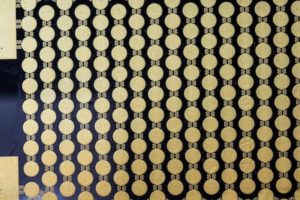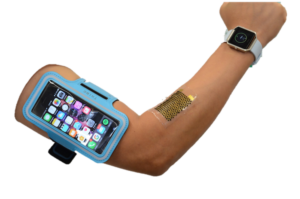
[Image above] Stretchable biofuel cells extract energy from sweat to power wearable devices. Credit: UC San Diego, Jacobs School of Engineering
Your sweat might someday power the radio you listen to while you work out.
An engineering team from the University of California San Diego has created a flexible fuel cell that generates energy from human sweat to power small electronic devices.
Led by Joseph Wang, distinguished professor and chair of the Department of Nanoengineering and director of the Center for Wearable Sensors at UC San Diego, the team developed a biofuel cell consisting of multiple rows of electrode dots—anodes and cathodes—connected by tiny springs that cause the support to bend and stretch. They needed the fuel cell to be flexible in order to incorporate it into wearable devices.
And these aren’t just ordinary anodes and cathodes that you would normally see on a battery. Wang’s team made them out of gold dots with what they termed a “bridge and island structure,” according to the university’s news release. They then screen-printed layers of biofuel materials on the raised anode and cathode dots.

The bridge and island structure allows the biofuel cell to be flexible and stretchable. Credit: UC San Diego, Jacobs School of Engineering
So where does sweat enter into the equation?
Sweat contains lactic acid, a compound produced in the body as a result of strenuous exercise. When you’re in the throes of an intense workout, oxygen levels drop, which produce additional lactic acid.
The research team added an enzyme called lactate oxidase to the device to oxidize lactic acid, generating a current to turn the sweat into a power source. But their biggest problem was that they needed to generate a LOT of energy. “We needed to figure out the best combination of materials to use and in what ratio to use them,” Amay Bandodkar, one of the paper’s first authors, says in the release.
The solution was more screen printing, this time packing a 3-D carbon nanotube structure over the anodes and cathodes to increase power density.
Carbon nanotubes, because of their high conductive properties, make for more efficient electron transfer—resulting in “an open circuit voltage of 0.5 V and a power density of nearly 1.2 mW cm−2 at 0.2 V,” according to the team’s research paper, and represents “the highest power density recorded by a wearable biofuel cell to date.”
Putting it to the test
Once they built the fuel cell, Wang’s team connected it to a circuit board and tested it on four people riding a stationary bike. In the paper, the scientists report that the biofuel cell generated ∼1 mW during exercise—enough to power a LED and a low-energy Bluetooth radio.
They also report that the fuel cell maintained performance under repeated strains of 50% and maintained stability for two days.

Researchers showed that the flexible biofuel cell could power LEDs and a Bluetooth radio. Credit: UC San Diego, Jacobs School of Engineering
Future research
Bandodkar says further testing is needed to address several challenges.
“The device relies on lactate oxidase enzyme, which degrades over time,” he writes in an email. “We need to find ways to stabilize the enzyme against degradation. We would like to further increase the power density of the system so that it can power electronics for longer durations.”
“It would also be great if we can combine the biofuel cell with other forms of wearable energy harvesting systems, such as wearable solar cells, thermoelectrics, etc., so that such an integrated energy harvesting system can produce energy from multiple sources.”
Sounds like our workouts may eventually serve a dual purpose of getting us in shape AND charging our devices.
The paper, published in Energy & Environmental Science, is “Soft, stretchable, high power density electronic skin-based biofuel cells for scavenging energy from human sweat” (DOI: 10.1039/C7EE00865A)
